Kia Picanto (JA): Child restraint system (CRS) / ISOFIX anchorage and toptether anchorage (ISOFIX anchorage system) for children
The ISOFIX system holds a Child Restraint System during driving and in an accident. This system is designed to make installation of the Child Restraint System easier and reduce the possibility of improperly installing your Child Restraint System. The ISOFIX system uses anchors in the vehicle and attachments on the Child Restraint System. The ISOFIX system eliminates the need to use seat belts to secure the Child Restraint System to the rear seats.
ISOFIX anchorages are metal bars built into the vehicle. There are two lower anchors for each ISOFIX seating position that will accommodate a Child Restraint System with lower attachments.
To use the ISOFIX system in your vehicle, you must have a Child Restraint System with ISOFIX attachments. The Child Restraint System manufacturer will provide you with instructions on how to use the Child Restraint System with its attachments for the ISOFIX anchorages.

ISOFIX anchorages have been provided in the left and right outboard rear seating positions. Their locations are shown in the illustration.
WARNING
Do not attempt to install a Child Restraint System using ISOFIX anchorages in the rear center seating position. There are no ISOFIX anchorages provided for this seat. Using the outboard seat anchorages, for the CRS installation on the rear center seating position, can damage the anchorages.
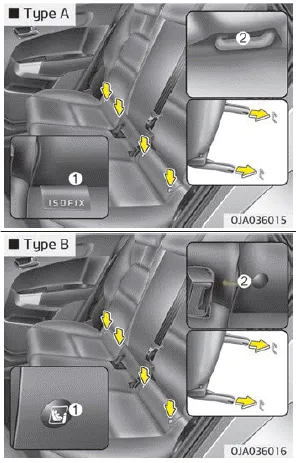
ISOFIX anchorages are located between the seatback and the seat cushion of the rear seat left and right outboard seating positions, indicated by the symbols.
❈ 1. : ISOFIX Anchor Position Indicator (Type A- ,Type B- )
2. : ISOFIX Anchor
Securing a Child Restraint System with the “ISOFIX Anchorage System
To install an i-Size or ISOFIX-compatible Child Restraint System in either of the rear outboard seating positions:
1. Move the seat belt buckle away from the ISOFIX anchorages.
2. Move any other objects away from the anchorages that could prevent a secure connection between the Child Restraint System and the ISOFIX anchorages.
3. Place the Child Restraint System on the vehicle seat, then attach the seat to the ISOFIX anchorages according to the instructions provided by the Child Restraint System manufacturer.
4. Follow the instructions of the Child Restraint System's manufacturer for proper installation and connection of the ISOFIX attachments on the Child Restraint System to the ISOFIX anchorages.
WARNING
Take the following precautions when using the ISOFIX system:
- Read and follow all installation instructions provided with your Child Restraint System.
- To prevent the child from reaching and taking hold of unretracted seat belts, buckle all unused rear seat belts and retract the seat belt webbing behind the child. Children can be strangled if a shoulder belt becomes wrapped around their neck and the seat belt tightens.
- NEVER attach more than one Child Restraint System to a single anchorage. This could cause the anchor or attachment to come loose or break.
- Always have the ISOFIX system inspected by your dealer after an accident. An accident can damage the ISOFIX system and may not properly secure the Child Restraint System.
Securing a Child Restraint System seat with “Top-tether Anchorage” system
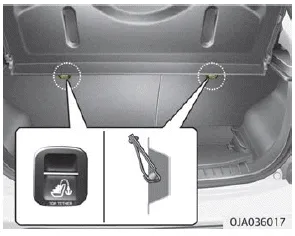
Child restraint system top tether anchorages are located on the back of the rear seatbacks.
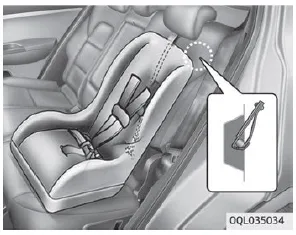
1. Route the Child Restraint System top-tether strap over the seatback. Placing the top tether strap, please follow the instructions of the Child Restraint System manufacturer.
2. Connect the top-tether strap to the top-tether anchorage, then tighten the top-tether strap according to the instructions of your Child Restraint System's manufacturer to firmly attach the Child Restraint System to the seat.
WARNING
Take the following precautions when installing the top-tether:
- Read and follow all installation instructions provided with your Child Restraint System.
- NEVER attach more than one Child Restraint System to a single ISOFIX top-tether anchorage. This could cause the anchorage or attachment to come loose or break.
- Do not attach the top-tether to anything other than the correct top-tether anchorage. It may not work properly if attached to something else.
- Child Restraint System anchorages are designed to withstand only those loads imposed by correctly fitted Child Restraint System.
- Under no circumstances are they to be used for adult seat belts or harnesses or for attaching other items or equipment to the vehicle.
Suitability of each seating position for ISOFIX Child Restraint Systems according to ECE regulations
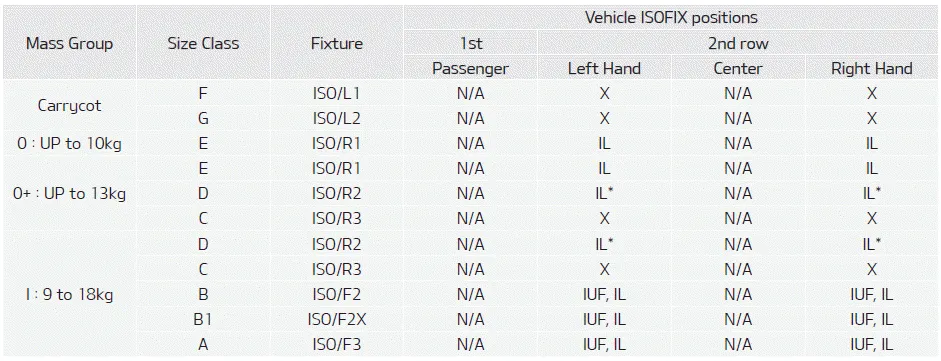
IUF = Suitable for ISOFIX forward child restraints systems of universal
category approved for use in the mass group.
IL* = Suitable for particular ISOFIX child restraints systems (CRS) given in the
attached list.
Front Driver Seat : Seat Height should be up highest position. (If height device
does not exist, Seat should be moved
10mm in front of mid position.)
Front Passenger Seat : Seat should be moved foremost position.
IL = Suitable for particular ISOFIX child restraints systems (CRS) given in the
attached list. These ISOFIX CRS are those
of the "specific vehicle", "restricted" or "semi-universal" categories.
X = ISOFIX position not suitable for ISOFIX child restraint system in this mass
group and/or this size class.
A - ISO/F3 : Full-Height forward-facing toddler Child Restraint System (height
720mm)
B - ISO/F2 : Reduced-height forward-facing toddler Child Restraint System
(height 650mm)
B1 - ISO/F2X : Reduced-height second version back surface shape forward-facing
toddler Child Restraint System
(height 650mm)
C - ISO/R3 : Full-size rearward-facing toddler Child Restraint System
D - ISO/R2 : Reduced-size rearward-facing toddler Child Restraint System
E - ISO/R1 : Infant-size rearward-facing Child Restraint System
F - ISO/L1 : Left lateral facing position Child Restraint System (carry-cot)
G - ISO/L2 : Right lateral facing position Child Restraint System (carry-cot)
Securing a Child Restraint System with a lap/shoulder belt
When not using the ISOFIX system, all Child Restraint Systems must be secured to a rear seat with the lap part of a lap/shoulder belt.
Installing a Child Restraint System with a lap/shoulder belt
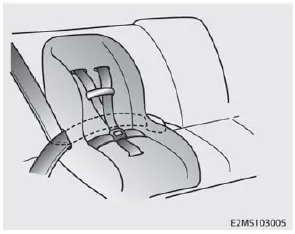
To install a Child Restraint System on the rear seats, do the following:
1. Place the Child Restraint System on a rear seat and route the lap/shoulder belt around or through the Child Restraint System, following the Child Restraint System manufacturer’s instructions. Make sure the seat belt webbing is not twisted.
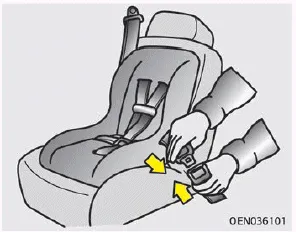
2. Fasten the lap/shoulder belt latch into the buckle. Listen for the distinct “click” sound. Position the release button so that it is easy to access in case of an emergency.
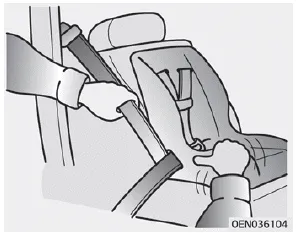
3. Remove as much slack from the belt as possible by pushing down on the Child Restraint System while feeding the shoulder belt back into the retractor.
4. Push and pull on the Child Restraint System to confirm that the seat belt is holding it firmly in place.
If your Child Restraint System manufacturer recommends the use of a toptether with the lap/shoulder belt.
To remove the Child Restraint System, press the release button on the buckle and then pull the lap/shoulder belt out of the Child Restraint System and allow the seat belt to retract fully.
Suitability of each seating position for "universal" category belted Child Restraint Systems according to ECE regulations (Rear seat for 2 people, For Europe)
Use Child Restraint System that have been officially approved and are appropriate for your children. When using the Child Restraint System, refer to the following table.

U = Suitable for "universal" category Child Restraint Systems approved for
use in this mass group
U* = Suitable for "universal" category Child Restraint Systems with Seat back
angle should be at upright position
UF = Suitable for forward facing "universal" category restraints approved for
use in this mass group
L - Suitable for particular child restraints given on attached list. These
restraints may be of the "specific vehicle", "restricted"
or "semi-universal" categories.
B - Built-in restraint approved for this mass group.
X - Seat position not suitable for children in this mass group.
❈ Never install a Child Restraint System with a support leg on the front
passenger seat and the second row center seat.
Suitability of each seating position for "universal" category belted Child Restraint Systems according to ECE regulations (Rear seat for 3 people, For Europe)
Use Child Restraint System that have been officially approved and are appropriate for your children. When using the Child Restraint System, refer to the following table.

U = Suitable for "universal" category Child Restraint Systems approved for
use in this mass group
U* = Suitable for "universal" category Child Restraint Systems with Seat back
angle should be at upright position
UF = Suitable for forward facing "universal" category restraints approved for
use in this mass group
L - Suitable for particular child restraints given on attached list. These
restraints may be of the "specific vehicle", "restricted"
or "semi-universal" categories.
B - Built-in restraint approved for this mass group.
X - Seat position not suitable for children in this mass group.
❈ Never install a Child Restraint System with a support leg on the front
passenger seat and the second row center seat.
Suitability of each seating position for "universal" category belted Child Restraint Systems according to ECE regulations (Except Europe)
Use Child Restraint System that have been officially approved and are appropriate for your children. When using the Child Restraint System, refer to the following table.

U = Suitable for "universal" category Child Restraint Systems approved for
use in this mass group
U* = Suitable for "universal" category Child Restraint Systems with Seat back
angle should be at upright position
UF = Suitable for forward facing "universal" category restraints approved for
use in this mass group
L - Suitable for particular child restraints given on attached list. These
restraints may be of the "specific vehicle", "restricted"
or "semi-universal" categories.
B - Built-in restraint approved for this mass group.
X - Seat position not suitable for children in this mass group.
❈ Never install a Child Restraint System with a support leg on the front
passenger seat and the second row center seat.
i-Size Child Restraint Systems according to ECE regulations

i-U = Suitable for i-Size "universal" Child Restraints Systems forward and
rearward facing
i-UF = Suitable for forward-facing i-Size "universal" Child Restraints Systems
only.
X - Seat position not suitable for i-size CRS.
❈ To install i-Size CRS
- Front Driver Seat : Seat Height should be up highest position. (If height device does not exist, Seat should be moved 10mm in front of mid position.)
- Front Passenger Seat : Seat should be moved foremost position.
Recommended child restraint systems – For Europe

❈ The Graco Junior III will be used without the backrest
WARNING Before installing your Child Restraint System always: Read and follow the instructions provided by the manufacturer of the Child Restraint System.
1. Driver’s front air bag* 2. Passenger’s front air bag* 3. Side air bag* 4. Curtain air bag* 5. Driver’s knee air bag* 6. Front passenger’s air bag ON/OFF switch* WARNING Even in vehicles with air bags, you and your passengers must always wear the safety belts provided in order to minimize the risk and severity of injury in the event of a collision or rollover.
Other information:
Kia Picanto (JA) 2017-2025 Service & Repair Manual: Headlamp Leveling Switch
Schematic diagrams Circuit Diagram Repair procedures Removal 1.Disconnect the negative (-) battery terminal. 2.Remove the crash pad lower panel. (Refer to Body - "Crash Pad Lower Panel") 3.Remove the crash pad side switch (A) after loosening the mounting screws.
Kia Picanto (JA) 2017-2025 Service & Repair Manual: Mode Control Actuator
Components and components location Component Location 1. Mode Control Actuator Description and operation Description The mode control actuator is located at the heater unit. It adjusts position of mode door by operating mode control actuator based on signal of A/C control unit.
Categories
- Manuals Home
- Kia Picanto Owners Manual
- Kia Picanto Service Manual
- Indicators And Gauges
- Windshield Wiper/Washer
- Air Conditioner Refrigerant/Compressor
- New on site
- Most important about car
